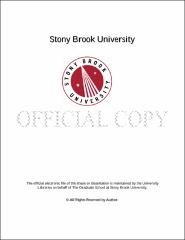| dc.identifier.uri | http://hdl.handle.net/11401/76563 | |
| dc.description.sponsorship | This work is sponsored by the Stony Brook University Graduate School in compliance with the requirements for completion of degree. | en_US |
| dc.format | Monograph | |
| dc.format.medium | Electronic Resource | en_US |
| dc.language.iso | en_US | |
| dc.publisher | The Graduate School, Stony Brook University: Stony Brook, NY. | |
| dc.type | Dissertation | |
| dcterms.abstract | Acetylcholine is an important neurotransmitter in the brain that plays a vital role in various aspects of cognition, including attention, spatial memory, and emotional memory. The role of cholinergic signaling in recognition memory, however, is less well understood. Recognition memory is a type of declarative memory and an important aspect of human cognition that is dependent on the perirhinal cortex. Cholinergic signaling within the perirhinal cortex appears to be especially important, as blockade of this signaling either pharmacologically or with selective lesions impairs recognition memory performance. Recognition is believed to be encoded by reductions in response of the perirhinal cortex upon exposure to previously experienced stimuli. This “reduction response†is dependent upon cholinergic signaling and thus cholinergic mediated long term depression is theorized to underlie recognition encoding. However, the effect of endogenous acetylcholine release in the perirhinal cortex has not previously been investigated. Here I probe for the first time the consequences of endogenous acetylcholine release in the PRH. I have also investigated the circuit level disruptions that may underlie recognition memory impairment in an animal model of intellectual disability. I have shown that the rate of reduction responses in the perirhinal cortex induced by ACh is the same as the rate of reduction responses induced by familiarity. Additionally, I have shown that when MeCP2 is deleted from cholinergic neurons, perirhinal cortex firing is impaired not only in its response to cholinergic input, but also in firing variability at baseline. Therefore cholinergic signaling in the perirhinal cortex is likely important both at baseline and after stimulation. Acetylcholine therefore may act over multiple time scales and via multiple mechanisms to subserve recognition memory. | |
| dcterms.available | 2017-09-20T16:50:39Z | |
| dcterms.contributor | Talmage, David | en_US |
| dcterms.contributor | Role, Lorna W | en_US |
| dcterms.contributor | Evinger, Leslie C | en_US |
| dcterms.contributor | Maffei, Arianna | en_US |
| dcterms.contributor | Robinson, John | en_US |
| dcterms.contributor | Kritzer, Mary. | en_US |
| dcterms.creator | Ballinger, Elizabeth C. | |
| dcterms.dateAccepted | 2017-09-20T16:50:39Z | |
| dcterms.dateSubmitted | 2017-09-20T16:50:39Z | |
| dcterms.description | Department of Neuroscience | en_US |
| dcterms.extent | 84 pg. | en_US |
| dcterms.format | Monograph | |
| dcterms.format | Application/PDF | en_US |
| dcterms.identifier | http://hdl.handle.net/11401/76563 | |
| dcterms.issued | 2017-05-01 | |
| dcterms.language | en_US | |
| dcterms.provenance | Made available in DSpace on 2017-09-20T16:50:39Z (GMT). No. of bitstreams: 1
Ballinger_grad.sunysb_0771E_13307.pdf: 3828069 bytes, checksum: e02ec4bc177a19038a29d8ceaef11e73 (MD5)
Previous issue date: 1 | en |
| dcterms.publisher | The Graduate School, Stony Brook University: Stony Brook, NY. | |
| dcterms.subject | acetylcholine, cholinergic, MeCP2, perirhinal, recognition memory | |
| dcterms.subject | Neurosciences | |
| dcterms.title | Cholinergic control of perirhinal cortex and recognition memory circuits | |
| dcterms.type | Dissertation | |

